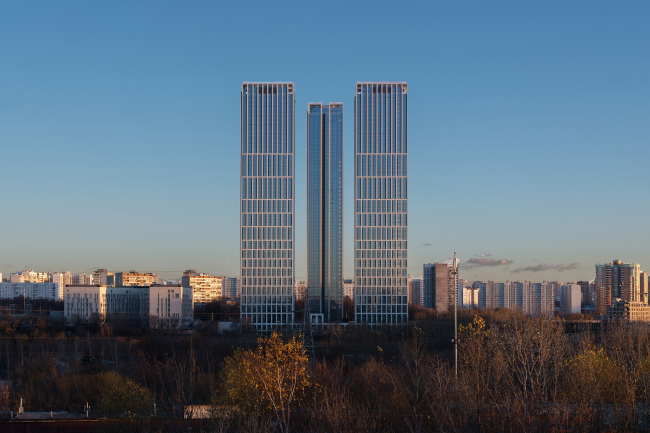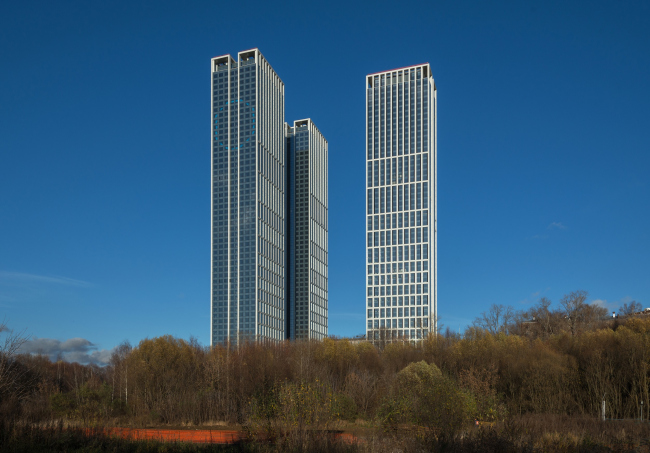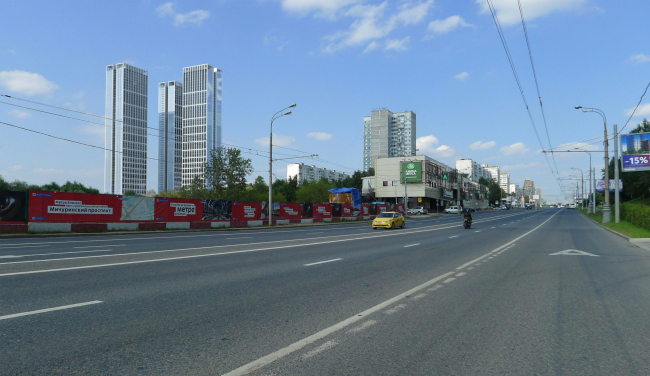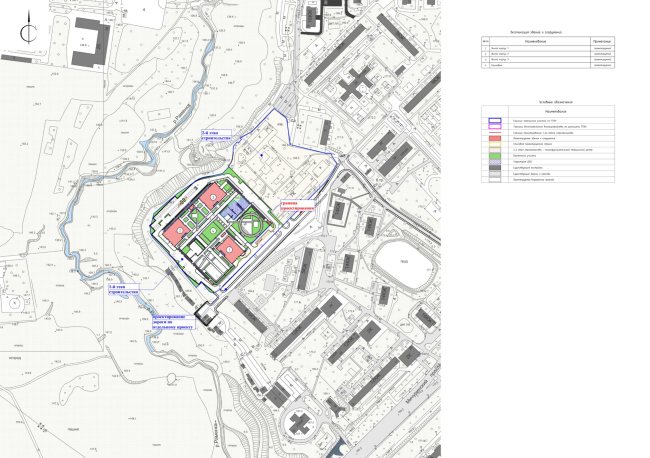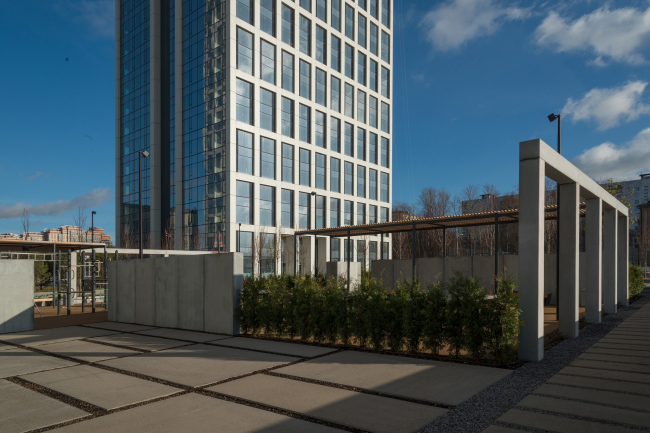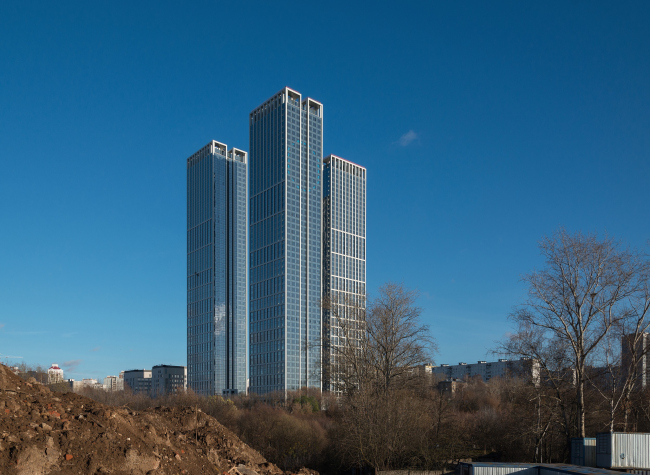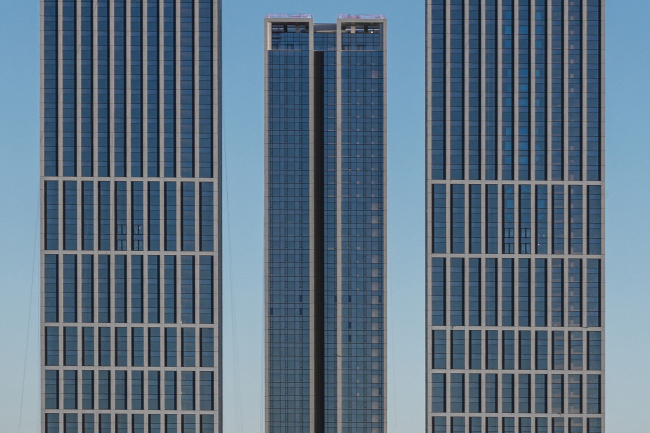|
Published on Archi.ru (https://archi.ru) |
|
| 08.12.2020 | |
|
Celestial Tectonics |
|
|
Julia Tarabarina |
|
| Architect: | |
| Vladimir Plotkin | |
| Studio: | |
| Creative Union ‘Reserve’ | |
|
Three towers on a podium over the Ramenka River are the new dominant elements on the edge of a Soviet “microdistrict”. Their scale is quite modern: the height is 176 m – almost a skyscraper; the facades are made of glass and steel. Their graceful proportions are emphasized by a strict white grid, and the volumetric composition picks up the diagonal “grid of coordinates” that was once outlined in the southwest of Moscow by the architects of the 1970’s and 1980’s. The three towers of the business-class residential complex “Nebo” (“Heaven”), which was quite recently, in November 2020, put into operation, are located in the very heart of Moscow’s prestigious southwest, between the Michurinsky Prospekt and Ramenki metro stations, 388 meters in a straight line from the Michurinsky Prospekt highway and on the border of the green zone, in the bend of the Ramenka river. The Moscow State University is a 10 minutes’ drive away, and so are a few large parks. In a word, the location is really advantageous. East of the complex, another mixed-use medical development is being built, designed by another architectural company. Nebo residential complex, view from the north, from the General Dorokhov AvenueThe southwest of Moscow, as is known, has long and well been familiar with high-rise residential construction. A few high-rise complexes are also being built within 1 or 2-kilometer radius. However, Ramenki 23 district is already full of housing projects, and, in addition, it is fenced off by the river, so one can safely assume that Nebo will remain the only dominant “flagship” element here. Another good thing is that, despite its large height (well, not 250 or even 400 meters tall, but still, almost 200) it does not “dominate” either when seen from a distance or from a close range – at most, it makes you lift your gaze. Which is definitely due to its graceful proportions, abundance of glass and white color, and the fine lightweight grid of the facades. Nebo residential complexCopyright: Photograph © Aleksei Naroditskiy / provided by TPO ReserveThe three residential towers are assembled in a symmetrical composition on an almost square two-tiered podium: two are built over the river along the edge of the northwestern facade, the third is placed perpendicular to them along the axis of symmetry of the base. The result is an austere T-shaped composition based on bringing together similar figures, with a vacant space in the middle. This is a solution, characteristic for Vladimir Plotkin, whose experiments with laconic geometry of turns and mirror flips, as well as with positioning similar figures within the framework of a single ensemble, are rather widely known (for example, this “turning similar figures” technique, yet not at 180, but at 90 degrees, was used for designing the Aeroflot office in Sheremetyevo Airport). 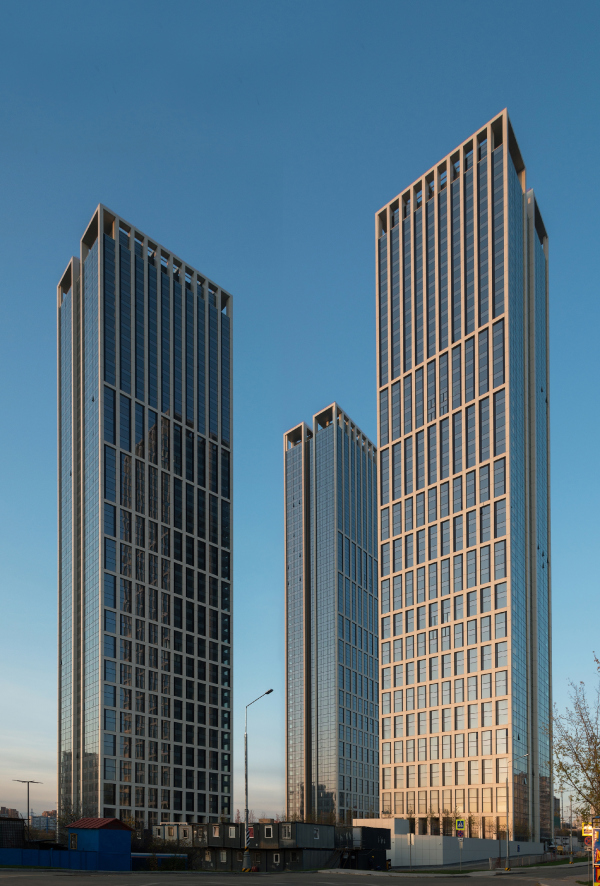 Nebo residential complex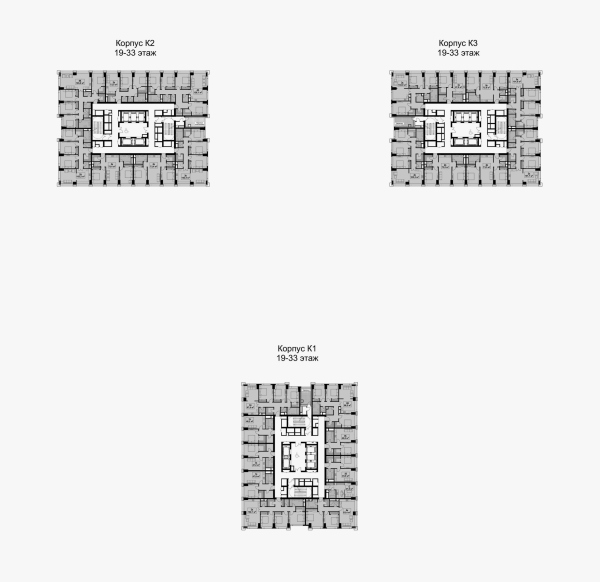 Buildings 1-3. A standard floorOn the plan, each of the towers is not a square but a rectangle of balanced proportions 8/10, with small “waist” cutaways in the middle of the narrow sides. The sidewalls are glass, while the long sides are subjugated to a white grid of vertical proportions. The lines, which grow out of the same grid, emphasize the projections of the sidewalls with thin white outlines, which makes the volumes seem to be composed of two plates glued together “like cookies” with a glass layer. 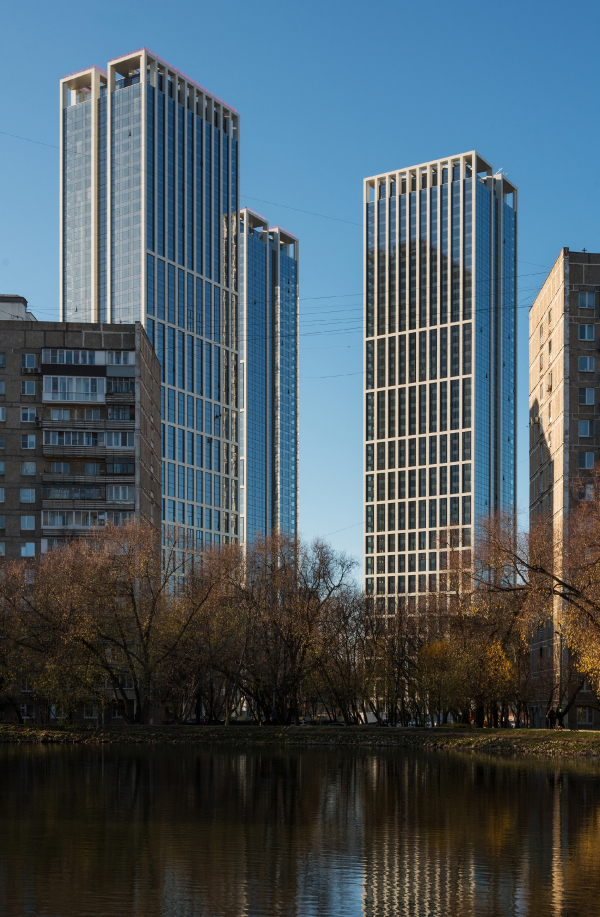 Nebo residential complex. Vew from the Ramensky Pond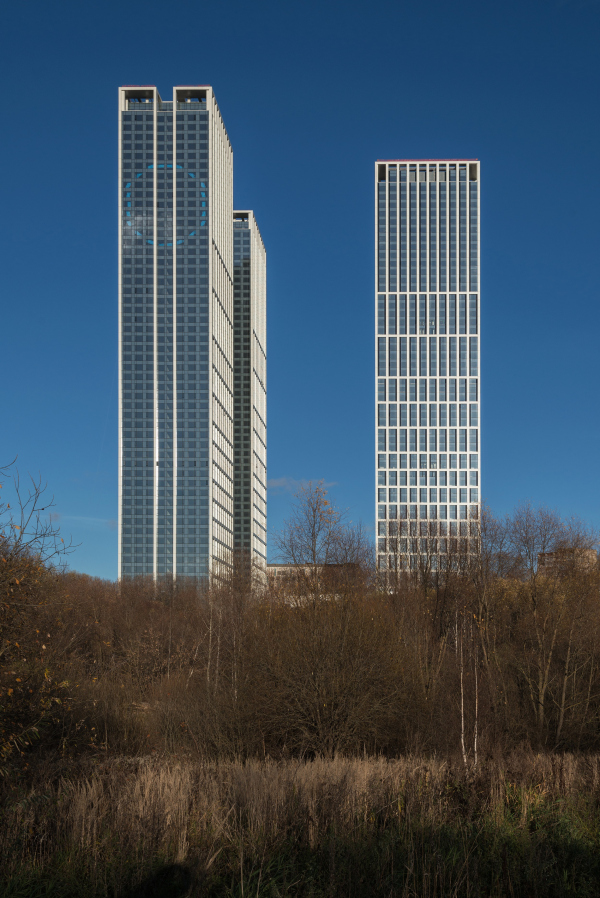 Nebo residential complex, view from the Lobachevskogo StreetThe lamellar structure makes the towers look slimmer and emphasizes the length of their volumes, but not only that. We need to make a little digression here: if you consider the context of the construction of the southwest of Moscow as a whole, you will easily notice the sparse, yet still connected by one common approach, network of highlight buildings belonging to the Soviet modernism of the 1970’s and 1980’s. These include Dom Turista on the Leninsky Avenue, the towers designed by Evgeny Rosanov on the Vernadskogo Avenue, and the buildings of the dormitories of the Moscow State University, located in the same area. All of these buildings are “pinpoint” and are essentially towers; many of them experiment with two-part lamellar structure, using the shift between narrow risalits as a slender vertical line. They pay a lot of attention to the podiums, which oftentimes grow from highly developed underground structures. Many of them have a cross-shaped plan, and almost all of them, maybe for the sole exception of the meridian towers of Dom Turista, follow the diagonal lines of the avenues of Moscow’s southwest, like some version of the Voisin plan. These buildings form the modernist backbone of the city’s southwest, points of power, whose energetics did not develop later, and in many respects was even overgrown with chaotically multiplied “mushrooms” (a term authored by Daria Paramonova) – but it is still felt all over the place. Anyway, many of the features that the modernist landmarks of Moscow’s southwest possess were aptly captured and implemented by the Nebo towers. The lamellar character and the slenderness of the towers have much been spoken about, but the arrangement of the wings also looks like a cross, the only difference being that the spot where the lines cross in not a volume, but a void, and, in addition, there is no “northern wing” here. It looks as though the architects took the characteristic composition apart piece by piece, at the same time preserving the main methods and approaches, so Nebo becomes yet another highlight of the southwest “network”. 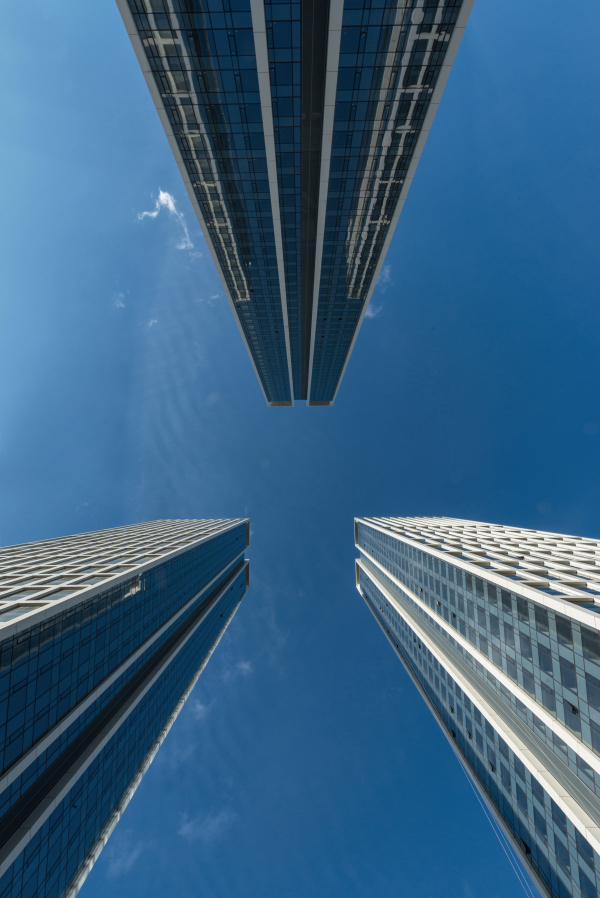 Nebo residential complex Nebo residential complexThus, the gesture is interpreted as a contextual one, made on a giant scale of a few kilometers, not just the nearest hundreds of meters. However, some sort of an “anchor” is still present nearby – it is a cross-shaped building on Michurinsky Avenue: if you watch from the south, the three towers look like its enlarged version, only with its components spaced apart. A project, simulation, view from the Michurinsky Avenue. On the righ: a 1980 residential building with a cross-shaped planHere one can notice that the strictly diagonal orientation of the land site and, as a result, of the houses standing on it, is supported not only by the line of the avenue and the urban planning grid of the Southwest Administrative District, but also by the bend of the Ramenka River, drawn by nature almost as if along a ruler. The 45-degree turn proved to be convenient for the natural insolation of the apartments: there are no walls that would gaze directly northward, and the lighting contour of the towers is used to its full potential. In addition, placing the buildings in a triangle with a considerable space between them eliminates the window-to-window situation, which is also good for a housing complex. The location plan. Nebo residential complexThe apartments are grouped along the lighting contour around the powerful staircase and elevator core: two staircases and five elevators. The range of apartments is quite wide, up to 4-room apartments, which corresponds to the business class of the housing complex. The ceiling height is 3.3 meters; in the bottom floors 4.5 meters. In front of the entrance, there is a recessed balcony, behind it there is a double-height lobby with a reception desk, on the side there is a public area with free Wi-Fi. 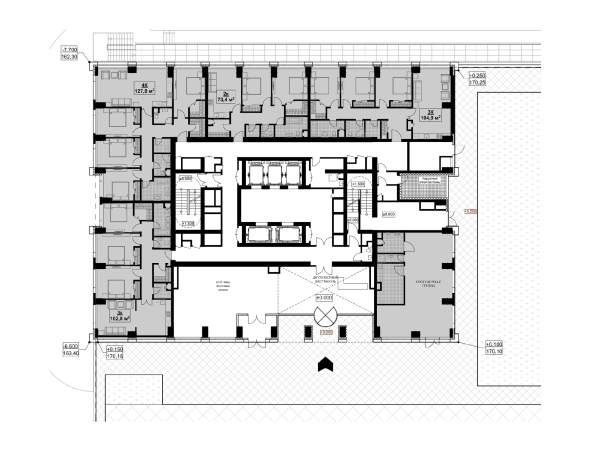 1st floor. Building 2 A standard floor. Building 2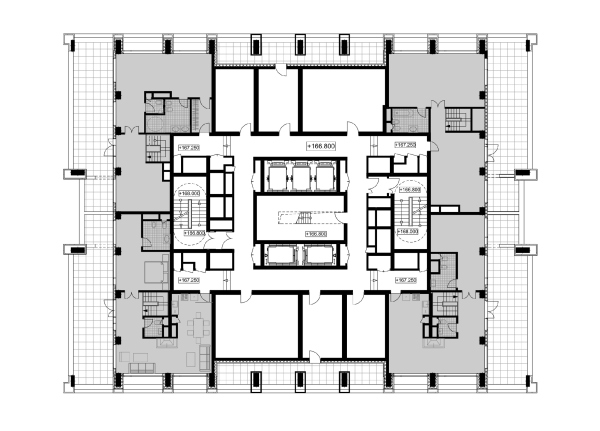 52nd floor. Building 2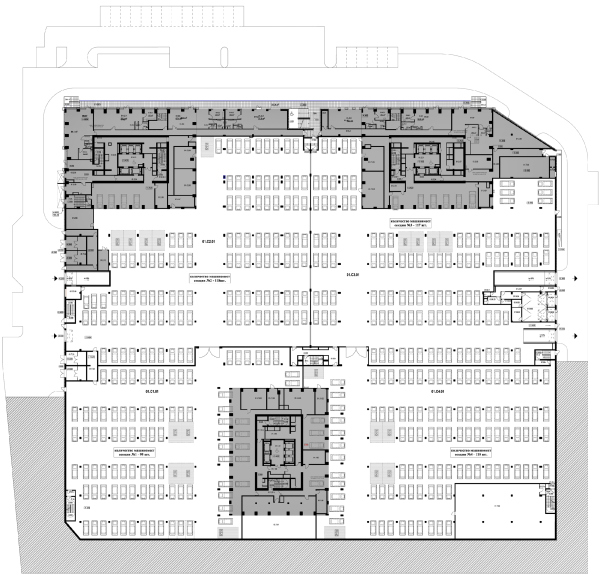 Ghe podium at -5.42 elevation. Nebo residential complexBack to the podium, though! It is inscribed into a slope with an 8-meter height difference from southeast to northwest, from the housing area towards the river. This is why from the side of the housing area, the podium rises only one and a half meters above the ground level, and you can enter the first parking level from the sides in a straight line, without a ramp. But, since the yard is elevated, this naturally makes it safe and car-free. From the northwestern edge of the podium, a steep slope to the river begins, meaning, the house, when viewed from this side of the river, practically rises out of the slope, like a kind of fort, with two northern towers continuing the surface of the podium. From this side, the two tiers of the podium host a string of offices stretching along the northwest façade. In front of them, in the lower tier, there is an extended platform; in the upper tier, there is a “gallery” balcony, accessed by an open-air staircase. This way the architects ensured that this the rear side of the complex above the river is not a “backyard”, but a fragment of a business urban space with its own recreational area, access to the air and even sweeping views, since the view of the river and the “semi-industrial half-city” beyond it is quite up to Moscow standards, and boasts abundant vegetation too. The bottom floors of the two towers, the central and the east ones, host a short-term stay kindergarten and infant development groups for 75 people. Between the towers, there is a playground belonging to the kindergarten, while the open east corner of the podium is occupied by a circular structure with an amphitheater, oriented northeast: sideways, one can see a view of the Ramensky Pond from here. The simplified master plan. Nebo residential complexThe podium roof, which serves as the private courtyard of the three towers, is modern, with playgrounds and sports fields, a workout area, artificial hills, and a variety of plants, including large trees from lindens to pines in special recesses with the necessary drainage. One can get to the podium by the staircases and ramps, the latter being used for emergency vehicles, should such need arise. The sides of the ramps and the yard space are curbed by white concrete railings, sometimes with glass inserts. The shadows of the trees on them are a separate subject for admiring the combination of natural forms and laconic modern design of this new fragment of urban space.  Nebo residential complex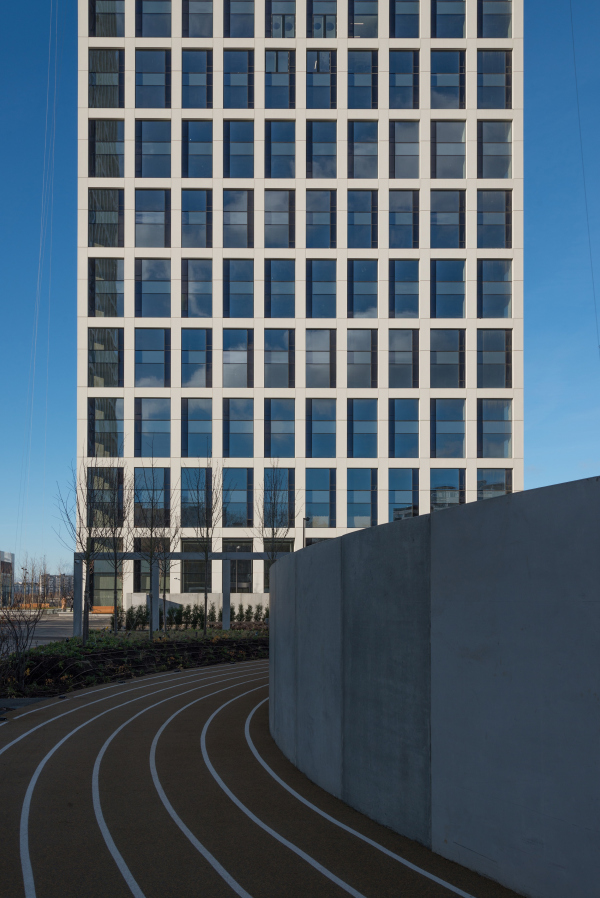 Nebo residential complex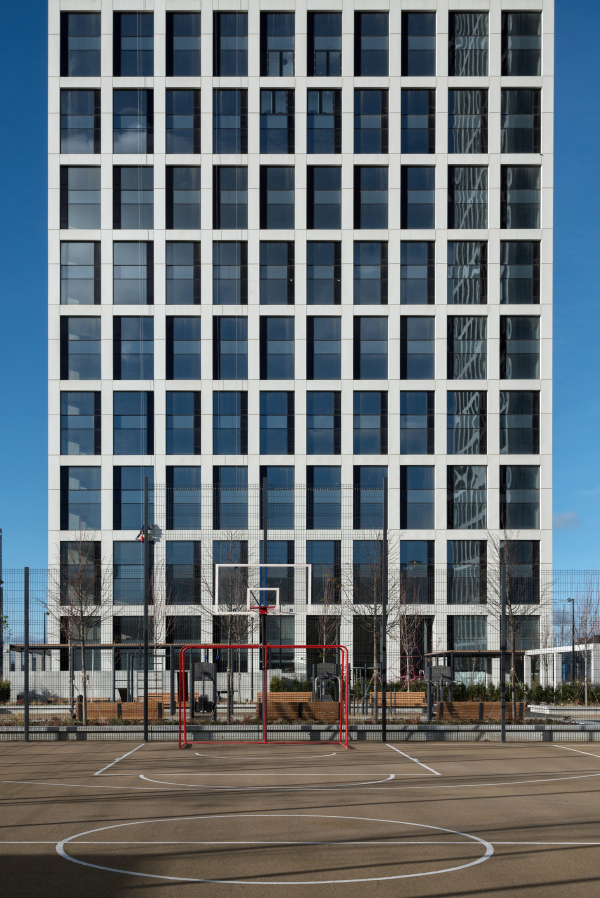 Nebo residential complex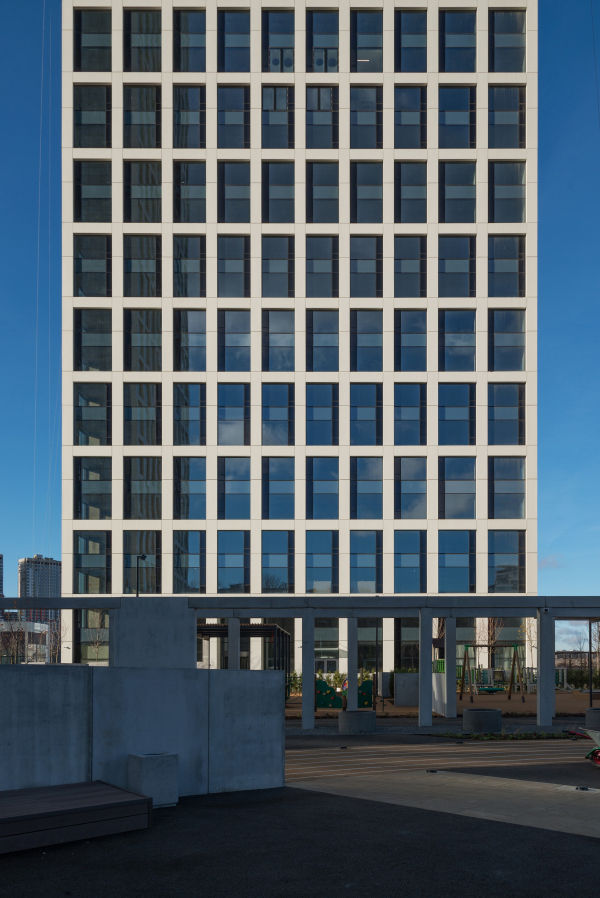 Nebo residential complex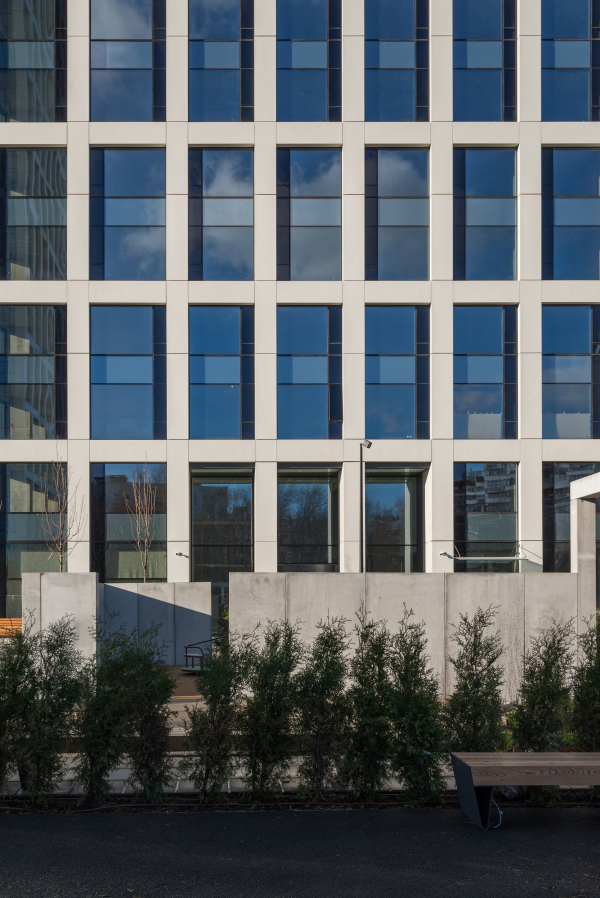 Nebo residential complex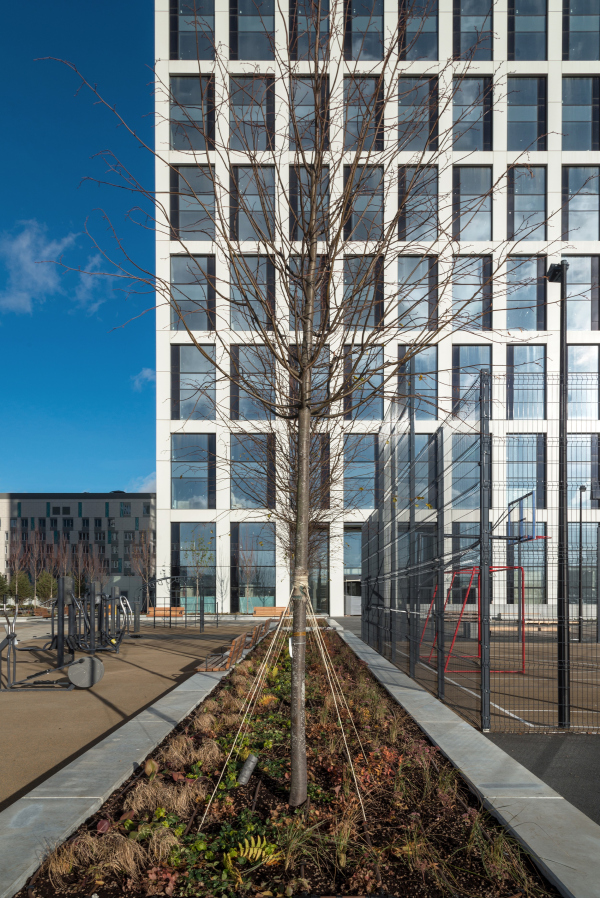 Nebo residential complexThe yard is zoned with strings of plants and concrete colonnades, whose simple pattern echoes the façade grid and looks like its logical continuation in space. Nebo residential complexThe eighteen bottom floors in all of the towers are vertically grouped in twos, so the grid of the white lines on the pedestrian level, or, should we say, a walking resident, looks calm and predictable. Higher up, however, it stretches in a gradient pitch, and not exactly in a smooth way: nine floors are grouped in three groups of threes, next ten are two fives, and, finally, the remaining 15 are continuous verticals. The penthouses on the upper floors step back from the edge with terraces, the straight grid lines continue, already without filling, forming a pergola covering both penthouses and ventilation shafts, masking the technical floor and giving the volumes their correct shape. These same lines frame the side walls, visually forming, as we saw above, the two-part character of the volumes. As if made of glass, the towers are encased in a fine, yet rigid-looking grid, which to a large extent defines their perception, particularly from a distance.  Nebo residential complex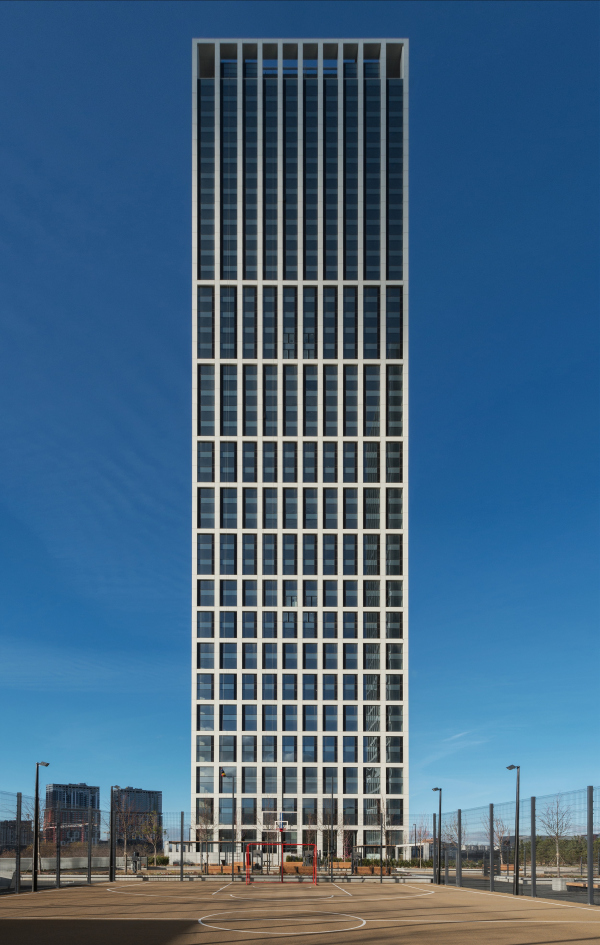 Nebo residential complexA vertically oriented façade grid is generally characteristic of Moscow of the last decade – we saw lots of its versions, both classicist and modernist. Buildings designed by Vladimir Plotkin have developed their own laconic version of this grid, most often white or monochrome with an occasional inclusion of bright color. Let’s compare, for example, the facades of the Prefecture of the Troitsky and Novomoskovsky administrative areas, an office building on the Krasina Street and two buildings within the VTB Arena Park. Interpreted like this, the façade grid not only makes the volume look more slender, collected, and lighter, but it also helps to position the form in space, governing the perception on the optical level: the clearly manifested façade lines accentuate all the oscillations, pauses, and turns “lead” one’s gaze and help to better understand the architectural statement. From time to time, the grid steps back from the volume and forms aerial structures: the galleries in the bottom floors and pergolas in the top ones. All these techniques work towards creating an integral image of Nebo. Here, however, the façade grid has two peculiar features. First, it is stretched vertically. The easiest way to explain this is by the effect of perception: if you look from the bottom up, the height of the cells in perspective will decrease and from a certain angle – from the yard, for example – the grid may seem to be uniform. However, if you look at the facades en face, the grid seems to be stretched from top to bottom, either under the influence of gravity, or as an effect of melting: as if the sun has heated the upper floors, and they “melted down”, but the cells at the bottom have not melted yet. In addition, if we are to look at the pattern in its entirety, the resulting effect reminds the growth of the cells in the central unit of the WineHouse residential complex.  Nebo residential complex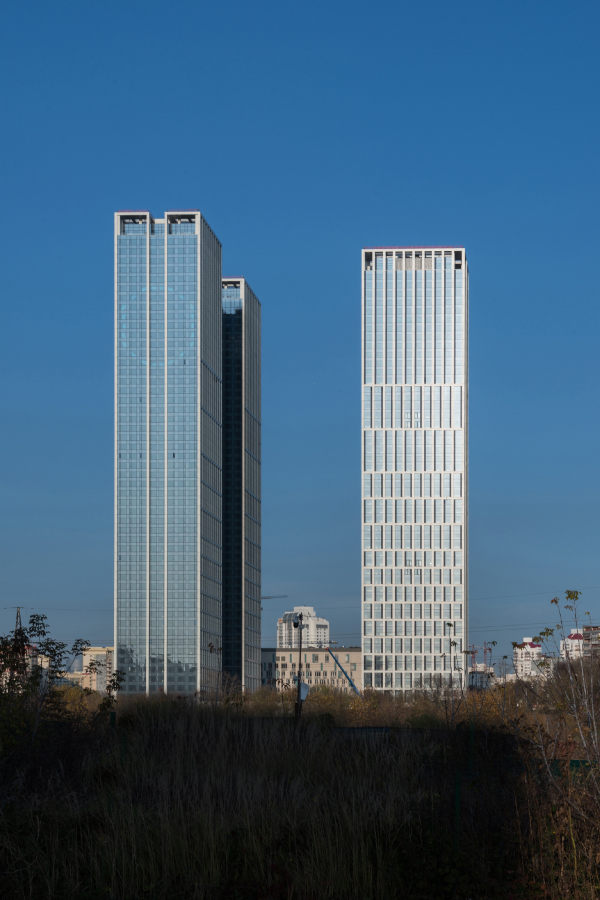 Nebo residential complexOne way or another, the stretched grid, on the one hand, contradicts the rules of the classical tectonics of the middle, top and bottom, while the very method of grouping the windows vertically is more likely to be defined as a classicist one (however, perhaps, the belief that “vertical is a classic, horizontal is modernism” is rather a matter of habit, because already in the 1970’s this statement was repeatedly refuted or, at any rate, the architects began experimenting with its antithesis). On the other hand, the transformation of the facade grid makes it more than just a checkered pattern but an instrument of dialogue with the urban environment, or perhaps, given the real estate name of the complex, with the shy as well – bearing such a name and boasting such a height, it would be a waste not to address the proximity of heaven in any way. Nebo residential complexThe other peculiar feature is that the glass surface is formed not only by a grayish stemalite in the intermediate floors – the textured white grid in each cell is outlined by an insert of black glass, similar to a shadow from the sun. What makes this whole thing even more interesting is the fact that in the end-to-end vertical ledges at the ends of the towers, a wide black stripe, similar to a shadow, arises from the recesses of the central air conditioning, yet, when seen from a from a distance, it is perceived as part of the general narrative, echoing the “marks” in the windows. (Here we will note in parentheses that the dark glass inserts are translucent and do not reduce the width of the window aperture when viewed from the inside; black glass in the windows corresponds to the vent panes). Nebo residential complexThis technique could be regarded as an illusionist element of grisaille supergraphics, like stripes that form a hint of vertical niches on the facades of the Chertanovo residential complex built in in 2008 – if it wasn’t for the fact that the black inserts alternate in a checkerboard pattern, floor by floor, left and right. This alternation, especially if viewed from some angles, where the “underscore marks” are perceived as part of the texture, creates the impression of a paradox: the tiers seem to “gaze” in different directions (a similar effect occurs in the 5th building of VTB Arena Park), or they seem to be stitched along the contour with a zigzag line or, maybe, they “wiggle” a little, vibrating – approximately like a mirage, especially when viewed from afar. Which, of course, puts one in the mid of Op Art experiments, particularly the false zigzag picture. 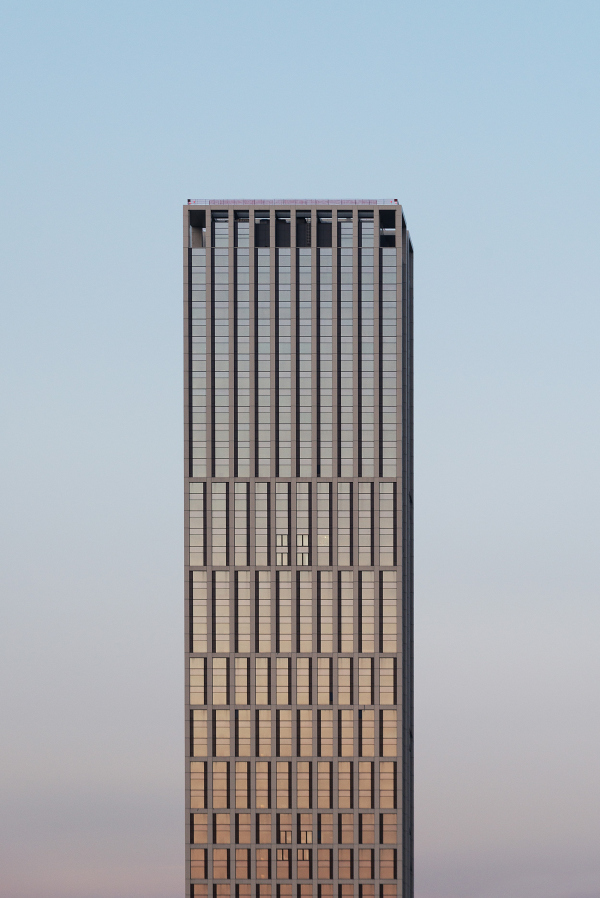 Nebo residential complex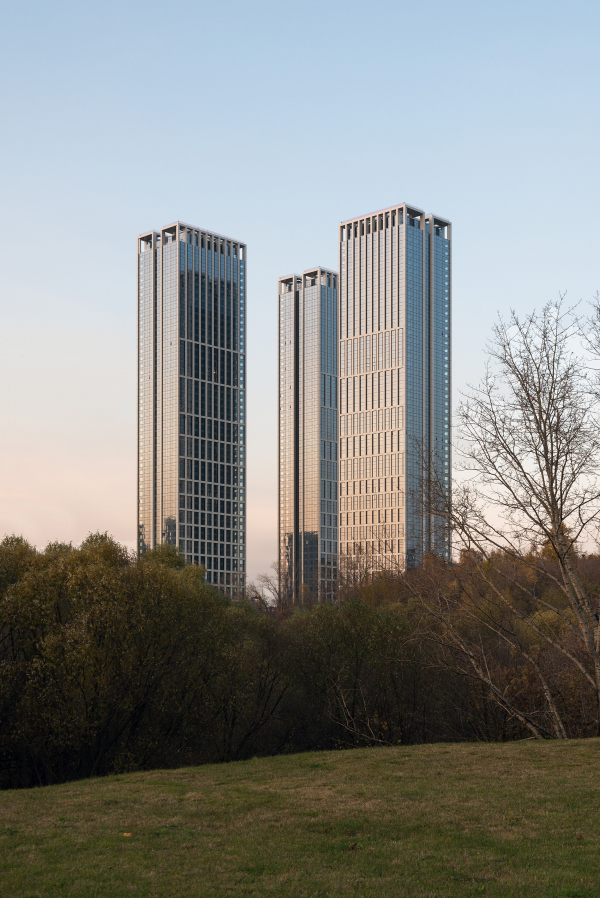 Nebo residential complex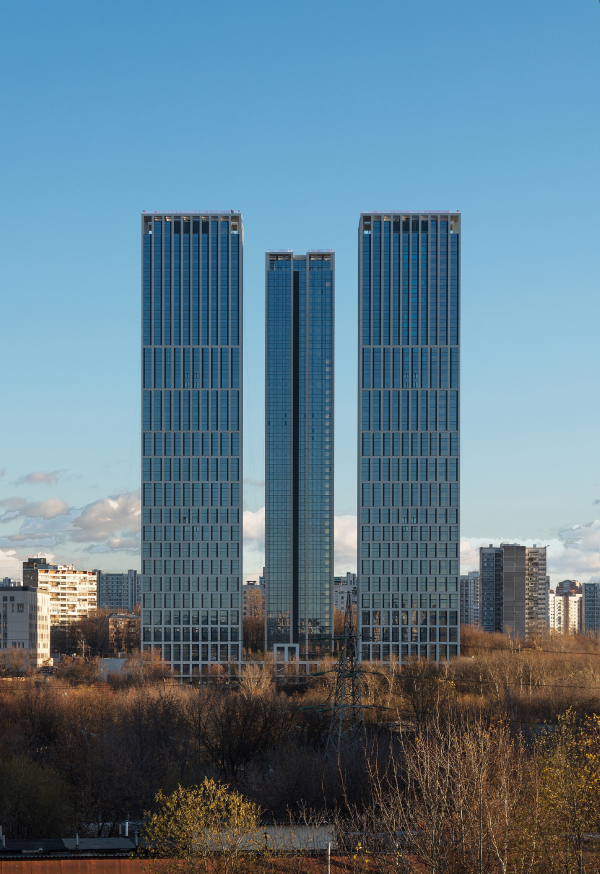 Nebo residential complex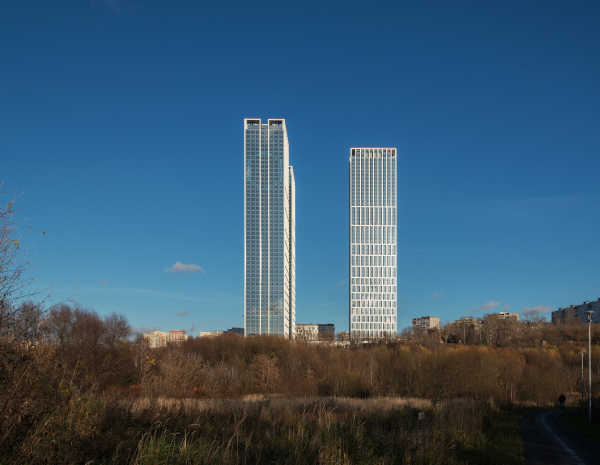 Nebo residential complexThe pattern is not always visible – in direct light it is almost obliterated, but in the slanting rays of the evening sun, it is quite noticeable – and the towers, despite the laconism of their design, look different not only when walking around, but also change depending on the time of day. The zigzag pattern also brings back the metaphor of melting: the lines of the façade grid, which at first glance seem straight and very clear, if not harsh, white on dark (and they ARE in fact straight) – suddenly start to seem a little zigzag from this perspective, as if an iceberg had started to melt. This is a rather interesting effect, even though quite unobtrusively presented. Another option for changing the image is at sunset, when the white color “disappears”: the towers also look like Chicago skyscrapers: the verticals are clearer, and the pergolas turn into “classic” attics. 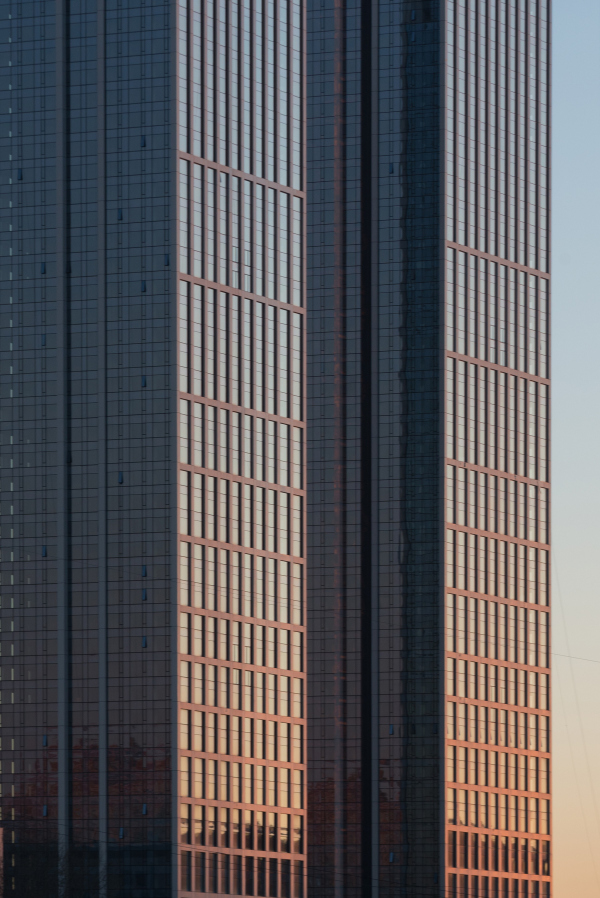 Nebo residential complex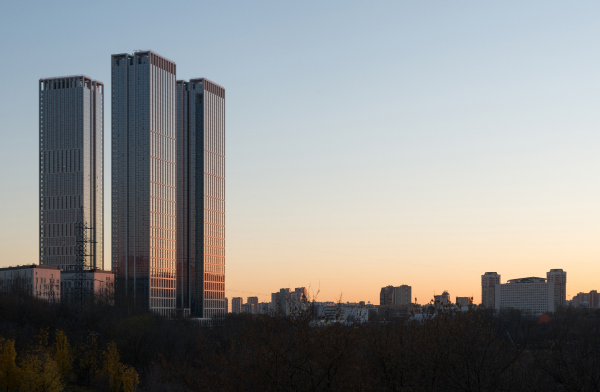 Nebo residential complexThe facades are steel and modular, manufactured at a factory, which ensured quality performance, good fire safety, and quick assembly. This solution corresponds to both the height restrictions and the business class of the complex. Nebo residential complex. The project, a fragment of the facadeIn the context of modern Moscow construction, the Nebo residential complex is high-rise, higher than the usual 25-35 floors, which have become the norm for large Moscow residential complexes, especially those that are being built nearby. In terms of height, it gravitates towards the “Big City” sphere of influence – but it’s still not a skyscraper. There are buildings higher than these. Strictly speaking, the arguments of visual analysis, whose limitations are observed here, are not very clear, just as it is unclear why it was impossible to build higher towers, making an even brighter landmark. These three buildings, of course, have become the dominant feature of the surrounding area, but at the same time, they balance on the verge between a skyscraper with steel facades and simply high-rise Moscow buildings. It is obvious, however, that if the same amount of useful floor space had been squeezed into harsher height restrictions on the same land site, the complex would not have looked so impressive. Here, however, the architects were really able to reach for the sky. At the same time fitting in very nicely with the town planning framework of the city, started by the architects of the seventies. |
|
